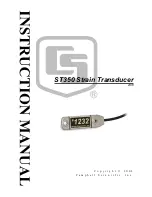
FLEX-6400/FLEX-6600 Hardware Reference Manual
Page
26 of 45
Copyright 2018 FlexRadio Systems. All Rights Reserved.
Δ –
CAUTION: USE CARE IN ATTACHING OR REMOVING SMA CONNECTORS. BEST
PRACTICE IS TO HOLD THE COAX WITH ONE HAND WHILE TWISTING THE SMA
CONNECTOR SHELL WITH THE OTHER. ONCE THE MALE AND FEMALE CONNECTORS
MATE, TURN UNTIL SNUG BUT DO NOT OVER TIGHTEN!
7.13
ETHERNET CONNECTOR
This is the network connection for the radio. It is an auto-sensing 100 megabit or 1
gigabit Ethernet port. It auto-senses polarity as well, so if you are using a direct
connection to your PC, you do not need a crossover cable. Refer to the SmartSDR
documentation for information as to the network configuration options.
7.14
USB 2.0 PORTS
The USB 2.0 ports are used for SmartSDR specific functions only. Do not connect
unqualified USB devices to the FLEX-6400/FLEX-6600. Refer to the SmartSDR
documentation for information about how these work.
7.15
EXTERNAL DISPLAY
External displays are not supported on FLEX-6400 and FLEX-6600 models.
7.16
10 MHZ INPUT
The external reference clock input is used to synchronize the radio’s master oscillator.
Requires a 1.0v p-p minimum to 3.3v p-p maximum (4dBm min - +15dBm max), sine or
square wave signal.
7.16.1
Radio Oscillator Startup
The radio can use the external 10MHz reference, the optional GPSDO reference, the
internal TCXO reference, or choose among them automatically. When set to automatic
mode, the radio prioritizes the reference signals in External, GPSDO and TCXO order. In
automatic mode, the radio watches for the appearance or disappearance of reference
signals and chooses the highest priority available signal. In manual mode, the radio uses
the selected input whether a signal is present or not. See the SmartSDR documentation
for more details.
7.17
TX RELAY OUTPUTS [1,2,3]
TX1, TX2 and TX3 are outputs for keying external equipment such as amplifiers, external
T/R switches, etc. They are isolated individual outputs. Refer to the SmartSDR
documentation for an explanation on how to configure the timing for each output.
















































